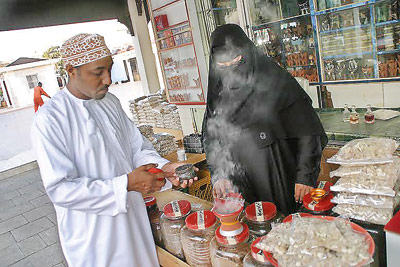A place where tears will always be bought and sold
“Please buy my tears,” she asked. She held the past in her hand.

A stall selling frankincense. Pic by Stuart Abraham
The Al-Husu market in the Al Hafa district of Salalah on the southernmost tip of the Sultanate of Oman, was crowded as it is every day.
On sale was everything from “musr” turbans, “kummah” caps, “naal” sandals to copper coffee pots , ceremonial “khanjar” daggers, ladies’ “thobs” and traditional velvet Dhofari “dishdasha” dresses.
But it is more famous for its teardrops. Ninety minutes’ flying time or a 1000km twelve-hour drive from the capital Muscat, Salalah has been known for centuries for the production of frankincense.
The Frankincense Trail is as ancient as the Silk Route. The 30km long, 20km wide coastal belt and the mountain range not far from the Yemeni border receives the “Khareef” south-west monsoon winds from June to September.
The mists blanket the region in an impenetrable pea-souper creating perfect conditions for growing frankincense trees. For four months Dhofar becomes the coldest place in the Arabic world. Before becoming the greenest.
“You will be amazed at the difference in landscape within a matter of miles,” explained my guide Naser Sulaiman Al-Mani as we drove past roadside stalls selling papayas , bananas and other fresh tropical fruit.
Coconut palms swayed above us. Grass grew all around us. Our destination was Wadi Dawqah , one of the oldest frankincense fields in the world.
It takes 14 months for a five foot frankincense tree-to become mature. A good tree can produce up to 10 kilograms of frankincense for up to 30 years.
Fields of spindly, rather sad-looking trees stretched miles under the cloudless sky. Naser put into the trunk of one. A thin white liquid bubbled from it.
“It is approved. We can all help ourselves and tap any tree any time,” Naser explained , cupping the liquid in his hands. “ It is a public resource.”
He invited me to try some frankincense sap. It was a little like coconut milk. But more bitter.
In the fourth century Wadi Dawqah area was the first place to produce frankincense for the global market. Frankincense has been central to many religious practices for many centuries.
It was used by King Solomon, Emperor Nero and Tutankhaman. It was Oman’s first oil.
There are various types of frankincense. From “Hougari” or “Hojary Superior” to “Nejdi” or “Nagdi”. The purest is colourless or with a slight green tinge. The best (silver or male ) is white-silver and brittle.
The cheapest is brownish-yellow. They all have a balsamic odour and a bitter aromatic taste. Once it has crystallized , frankincense burns easily and slowly with a bright white flame.
The most sought-after is breast-shaped like the union of two tears. Prices range from £1.50 to £70 per kilo.
The habit of perfuming your house with “Bukhoor” is a way of Arab life. Passing around an incense burner or “Mabkhara’’ is considered a mark of respect and hospitality.
The type of frankincense you use can be seen as a status symbol or at least symbol of sophistication rather than wealth. In Oman, frankincense is also chewed to relieve indigestion and freshen the mouth.
Public places have huge frankincense censures. But Oman is not all about frankincense.
Oman is modernizing itself. Oman is going large. In Muscat the Ibadi Islam muezzins compete through megaphones from their minarets with charter jets and construction work.
Paintings of the Sultan stand alongside corporate logos. The souks are competing with spas and wellness centres. Date cultivation has given way to investment cultivation.
Investor appetites are being stimulated. The traditional arts and crafts are being overwhelmed by the modern sciences of engineering , PR and hotel and catering. The country has a six-star hotel, the Shangri-La All Bissah.
But Salalah is ancient Oman. It is a fast-developing country’s one last link to an illustrious and affluent past. “ Dhofar is a unique and fascinating place, “ said Naser as we sat having lunch of “ narjeel” and “hamoor” fish in the “Al Fareed” restaurant on 23rd July Street – named after the day of the Sultan’s accession.
“The area is so lush and verdant. And only two hours over the mountains from the Empty Quarter , the Rub al Khali or desert.
The explorer Sir William Thesiger set out from Salilah to discover the Lost City of Ubar , “the Atlantis of the Sands”. The city museum has a permanent exhibition of his photographs.”
South Oman is still a place of ancient cities and old ways of life. Up in the “Jebel” foothills at JableIttin there is the Tomb of Job (Nabi Ayoub ) who is mentioned in both the Koran and the Bible.
The Queen of Sheba’s palace was in KhorRuri near Samhuram which was famous as a frankincense port. The current Sultan was born in Salalah and he has his summer residence there at the Al Husn Palace.
The Dhofar region is also the final resting-place of Nabi Imran , the father of the Virgin Mary as well as Emran , the father of Moses.
Naser reeled off the sights -the world’s second largest blowhole, the ninth century ancient capital of Mirbat and the botanical gardens at Ayn Razat.
Enthusiastic naturalists take the very long day drive to the Arabian Oryx sanctuary on the Jiddat Al-Harasis plateau near Haima.
This huge protected area in the desert is not only the home to one of only two herds of wild free-ranging oryx but also Nubian ibex, Arabian wolves , honey badgers and Arabian gazelle.
“Southern Oman is natural Oman. Old Oman,” were Naser’s parting words.
Muscat may be changing itself. But Salalah will never change. Frankincense will always be a reminder of the past. In the desert valleys you can see the past.
In the souks of Salalah you can see the present and the future. But tears will always be bought and sold.


